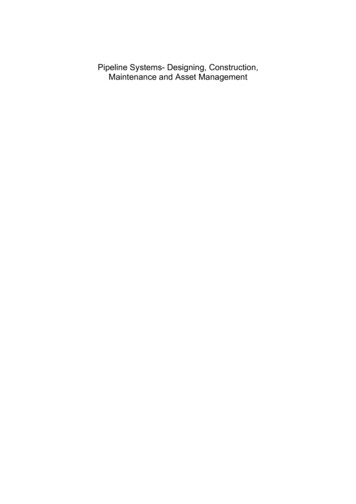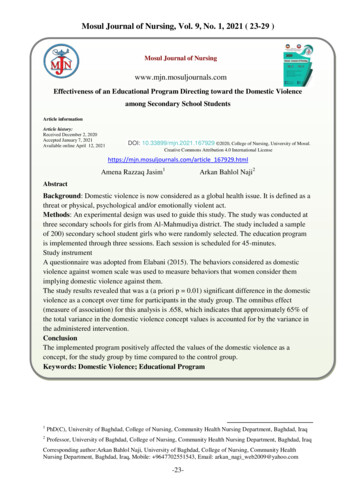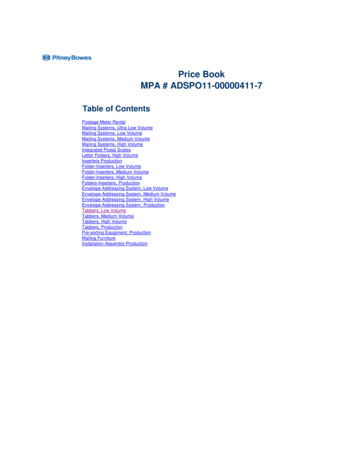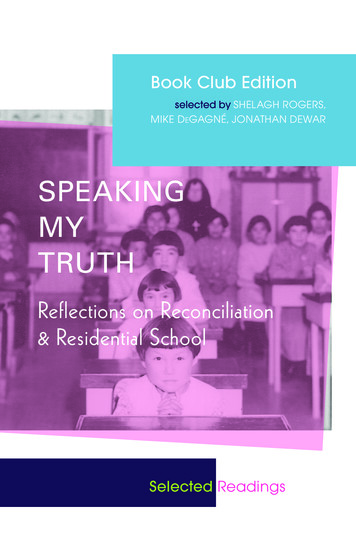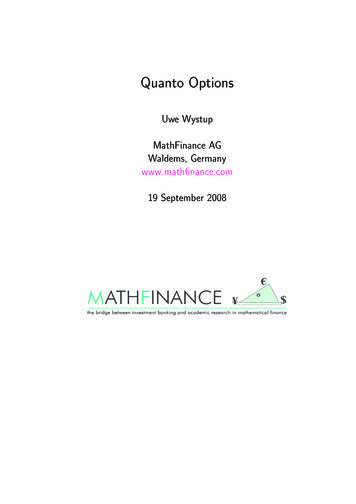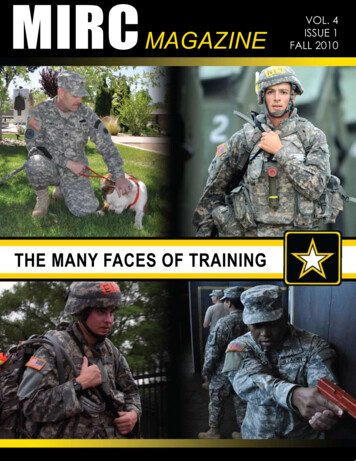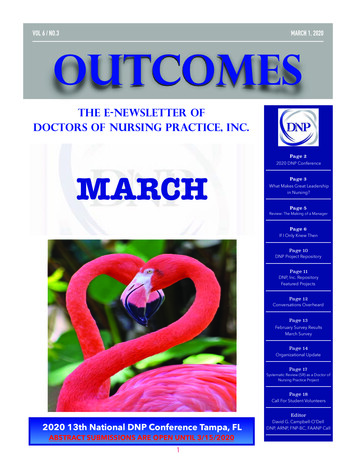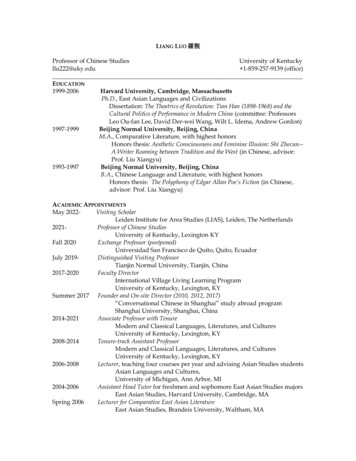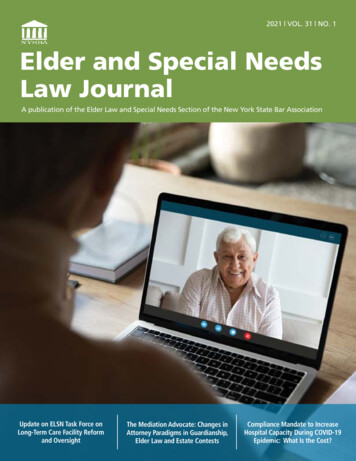
Transcription
2021 VOL. 31 NO. 1Elder and Special NeedsLaw JournalA publication of the Elder Law and Special Needs Section of the New York State Bar AssociationUpdate on ELSN Task Force onLong-Term Care Facility Reformand OversightThe Mediation Advocate: Changes inAttorney Paradigms in Guardianship,Elder Law and Estate ContestsCompliance Mandate to IncreaseHospital Capacity During COVID-19Epidemic: What Is the Cost?
CLEAll Access PassMaximize Your Time and EarnCLE Credits with On-Demand LearningAccess hundreds of programsonline and satisfy your MCLErequirement for one low price.Now IncludesAnnual Meeting 2021Programs! Gain access to all CLE Online video programs andcourse materials for one year New programs added each month Monthly billing option 495 forNYSBA MembersFor more information visit NYSBA.ORG/ALLACCESSPASSOnline only. Does not include live programs, CD or DVD products.All Access Pass requires member login and cannot be transferred. Annual subscription required.
ContentsFeatures8Some Ethical Musings During a PandemicRobert P. Mascali and Amy S. O’Connor12Testamentary Capacity and the Elusive LucidInterval: With Tips for Assessing CapacityDuring the COVID-19 PandemicChristina Lamm15Creative Approaches to Senior Housing forPersons with Cognitive ImpairmentDeborah S. Ball and Neil T. Rimsky17Elderly Clients, Not Ancient TechnologyDaniel R. Miller24Details MatterPenny B. Kassel25Compliance Mandate to Increase HospitalCapacity During COVID-19 Epidemic:What Is the Cost?Antonia J. MartinezElder andSpecial NeedsLaw Journal2021 Vol. 31 No. 1Regulars3Message Fromthe Section ChairMatthew Nolfo7Message Fromthe Co-EditorsKaty Carpenter andPatricia Shevy27Special Needs Planning: Back to BasicsMelissa Negrin-Wiener30The Mediation Advocate: Changes inAttorney Paradigms in Guardianship, ElderLaw and Estate ContestsBeth Polner Abrahams, Harriette M. Steinbergand Elizabeth Pollina Donlon1922Member Spotlight:Myles Fischer34Update on ELSN Task Force on Long-TermCare Facility Reform and OversightJoanne Seminara and David Kronenberg23Adventures in a BusyElder Law/T&E OfficeAntony Eminowicz37Retirement Account Treatment for EmployedSSI-Related Medicaid ApplicantsNicholas N. Khayumov39Section Committeesand ChairsNew MemberSpotlight:Arthur Conte
Section OfficersChairMatthew J. NolfoMatthew J. Nolfo & Associates275 Madison Ave, Ste 1714New York, NY kar Mukerji445 Hamilton Ave, Ste 1102White Plains, NY 10601dmukerjilaw@gmail.comVice-ChairChristopher R. BrayRheinhardt & Bray, PCPO Box 36085 Otsego StIlion, NY 13357cbray@cnyelderlaw.comSecretaryFern J. FinkelFinkel & Fernandez LLP16 Court Street, Ste 1007Brooklyn, NY 11241ffinkel@ffelderlaw.comTreasurerBritt N. BurnerBurner Law Group, P.C.45 W 34th St, Rm 1203New York, NY 10001bburner@burnerlaw.comFinancial OfficerSalvatore M. Di CostanzoMaker, Fragale & Di Costanzo, LLP350 Theodore Fremd AveRye, NY 10580smd@mfd-law.comElder and Special Needs Law JournalCo-Editors-in-ChiefBoard of Editors (continued)Katy CarpenterWilcenski & Pleat PLLC5 Emma LnClifton Park, NY 12065kcarpenter@wplawny.comChristine Anne MooneyQueensborough Community College265 Sunrise Hwy, Ste 1-119Rockville Centre, NY 11570chmesq@aol.comPatricia J. ShevyThe Shevy Law Firm, LLC5 Washington SqAlbany, NY 12205patriciashevy@shevylaw.comTara Anne PleatWilcenski & Pleat PLLC5 Emma LnClifton Park, NY 12065TPleat@WPLawNY.comBoard of EditorsGeorge R. TilschnerLaw Office of George R. Tilschner, PC7 High St, Ste 302Huntington, NY 11743gtilschner@preservemyestate.netErik J. EinhartRusso Law Group, P.C.100 Quentin Roosevelt Blvd, Ste 102Garden City, NY 11530EJEinhart@vjrussolaw.comLee A. Hoffman, Jr.Hoffman and Keating PC254 South Main St, Ste 200New City, NY 10956lhoffman@hkelderlaw.comLauren I. MechalySchenck, Price, Smith & King, LLP9 E 40th St, Fl 14New York, NY 10016LIM@spsk.comSara MeyersEnea Scanlan & Sirignano LLP245 Main St, Fl 5White Plains, NY 10601s.meyers@esslawfirm.comAssociate EditorKim F. TrigoboffLaw Offices of Kim F. Trigoboff1140 Avenue of the AmericasNew York, NY 10036kimtrigoboff@gmail.comProduction EditorLauren C. EneaEnea, Scanlan & Sirignano, LLP245 Main St, Fl 5White Plains, NY 10601L.Enea@esslawfirm.comNYSBA.ORG/ELDERImmediate Past ChairTara Anne PleatWilcenski & Pleat PLLC5 Emma LnClifton Park, NY 12065tpleat@wplawny.comThe Elder and Special Needs Law Journal is published by the Elder Law and Special Needs Section of the New York State Bar Association.Members of the Section receive a subscription to the publication without a charge.Accommodations for Persons with Disabilities:NYSBA welcomes participation by individuals with disabilities. NYSBA is committed to complying with all applicable laws thatprohibit discrimination against individuals on the basis of disability in the full and equal enjoyment of its goods, services, programs,activities, facilities, privileges, advantages, or accommodations. To request auxiliary aids or services or if you have any questions regarding accessibility, please contact the Bar Center at 518-463-3200.Publication Date: March 2021 Copyright 2021 by the New York State Bar As so ci at ion.ISSN 2161-5292 (print)ISSN 2161-5306 (online)
Message from the Section ChairBy Matthew NolfoHappy and healthy New Year to all. Looking forwardto a 2021 with less COVID-19 and more interaction withour families, friends, clients and colleagues.from April 1, 2021 to July 1,2021.It continues to be challenging to be the Chair of thisSection during COVID-19. But some good things havebeen happening. We have made progress in dealing withthe New York State Department of Health (DOH) on thenew transfer rules that affect Community-Based LongTerm Care (CBLTC), on the Power of Attorney legislation,and in a variety of other areas, thanks to the help of manySection members.As we have previously emphasized, the aforementionedadvisements by the Department of Health have not beenreduced to written policy andat this time are “unofficial,”and all Section members shouldproceed with some level of caution until an ADM is issued.Status of CBLTC Transfer Rules and RelatedChangesCommencement of PenaltyPeriodThe officers and other members of the Section continue to advocate for our clients in light of the imminentimplementation of the new CBLTC transfer rules. Wehave had several meetings with DOH and have sent themseveral memos advocating for our positions. The most recent meeting was on December 8, 2020. We have followedup with DOH since then and are in the process establishing a “working group” between our Section and DOH totry to resolve the differences we still have.The question of when and how a penalty on anygift will be triggered if a new application is made afterthe implementation date appears fairly clear. The DOHhas advised that this will require the standard forms forCBLTC Medicaid along with a simplified form to be filledout by a doctor. This will be a medical form devised byDOH intended to indicate whether CBLTC services areneeded. We have offered to help DOH in developing thismedical form.Look-BackPooled TrustsThe DOH had again confirmed that the look-backwill only apply to transfers made on or after October 1,2020 and that there will be no retroactive application ofthe new law.This issue remains the most unresolved with respectto how payments of income for home care recipients ages65 or older will be treated. The Department of Health hasadvised that a penalty will be assessed for any incomecontributions made to pooled trusts that are not used forthe benefit of the pooled trust beneficiary in the samemonth those income contributions are deposited. WhileDOH realizes that as a practical matter, not only wouldthis be difficult to administer on a monthly basis, but thatthere are also expenses that our clients have that are notdue on a monthly basis such as real estate taxes, homeowner’s insurance, and other one-time expenses that cannot always be planned for. As such, DOH seemed willingto consider other ways to monitor pooled trusts on orafter the implementation date of the new law.The DOH had determined that it would begin implementing the new law as of April 1, 2021 with respect toeither new applications for CBLTC or for conversion applications from basic Medicaid to Medicaid with CBLTCservices. The DOH has advised that for a new application filed before the April 1, 2021 where a gift had beenmade on or after October 1, 2020, that the transfer wouldnot be subject to a penalty. Moreover, the Federal PublicHealth Emergency (PHE) Declaration was just renewedfor another three months and will last through April 20,2021. As a result, DOH has just now advised this shouldmean that all of the COVID-19 easements, such as the banon terminating or reducing Medicaid, should continuethrough July 1, 2021 and that everything else under GIS20 MA/04—Coronavirus (COVID-19) —Medicaid Eligibility Processes During Emergency Period—should alsobe extended. As a result, DOH advised that the implementation date of the new transfer rules has been movedMatthew NolfoIn our dealings with DOH, we have asked that therebe a presumption that every deposit into a pooled trustwill be used for the pooled trust beneficiary and willtherefore be considered a compensated transfer. In theevent that there is an accumulation of contributions at anytime that are not used for the beneficiary, we have askedfor Medicaid not to impose a penalty but instead give theNYSBA Elder and Special Needs Law Journal 2021 Vol. 31 No. 13
beneficiary a reasonable time to use the funds on his orher behalf and to treat the overage as a resource problemand not a penalty problem. This request has been advocated by our Section as well as a number of pooled trustorganizations that have collectively made similar proposals to DOH, with whom we have conferred on variousoccasions. At this time, DOH has advised that they do notfeel they can alter their position without permission fromCMS.Recently, a decision was issued by Minnesota’s highest court (The Pfoser case) which appears to support thenotion that transfers to a pooled trust for beneficiarieswho are 65 and older are exempt transfers because theycan be deemed to be made for valuable consideration.This case is being closely reviewed by our LegislativeCommittee.Immediate NeedWe also asked that the immediate need attestationform for Home Care services be amended to includea statement about the applicant not having made anydisqualifying transfers that would make the applicant ineligible for home-based Medicaid for any period of time.This request was partially objected to by DOH. The DOHhas advised that an attestation can be made with respectto gifts of bank accounts and real estate because its AVSsystem can easily verify whether gifts of these types ofassets were made. But thus far, DOH has advised that alook back will apply for transfers of other types of assets.Moreover, DOH could not confirm that the medical portion of the Immediate Need Application will only requirethe current physician’s order or the more involved assessments that are provided for under the amendmentsto 18 N.Y.C.R.R. 505.14 and 18 N.Y.C.R.R. 505.28. This issomething the working group between our Section andDOH would seek to resolve if possible.Undue HardshipThere is currently no undue hardship exemptionfor transfers that could be disqualifying for home-basedMedicaid and we are working with DOH on a provisionthat would make sense to protect applicants who havemade gifts that would cause a penalty and cannot be easily returned. We are confident that we will be able to getDOH to include some type of undue hardship provisionsas part of the implementation of the new gift and penaltyrules for CBLTC.HomesteadDuring our December 8 call, we set forth our positionthat under the new look-back provisions, since ownership of the home does not affect the applicant’s eligibilityfor CBLTC services, the transfer of the home should beexempt as a transfer made exclusively for a purpose otherthan to qualify for Medicaid and such transfers should bepermitted to be made to persons or entities that are notdeemed to be exempt if the transfer was made by an institutionalized person. Social Services Law Section 366(5)(d)(3)(iii); 18 N.Y.C.R.R. Section 360-4.4(c)(2)(iii)(d)(1)(ii). Seealso Mondello v. D’Elia, 39 N.Y.2d 978, 355 N.E.2d 286, 387N.Y.S.2d 232. On the call, DOH preliminarily disagreedwith our position. Thanks to the research done by Sectionmember Richard Weinblatt, we have since set forth thereasons why we believe our position is correct and haveforwarded our position to DOH in early January.Power of Attorney LegislationAs many of you know, after several years of advocacy, the legislation that amends the current Power of Attorney law proposed through this Section was passed byboth houses of the legislature in July and signed into lawby the Governor in December. However, the new law issubject to a chapter amendment agreed to by the Governor and the legislature. The new form will take effect onJune 13, 2021. The overall goals of the new law have beenachieved. Among many other changes, Powers of Attorney only have to substantially comply with the wordingin the statute; the Gifts Rider has been eliminated andPowers of Attorney may now be signed at the direction ofthe Principal. In addition, the Chapter Amendment willrequire two witnesses (one of whom can be the notary)for all Powers of Attorney. There has already been a webinar done on the new form and there will be at least onefurther webinar done before the effective date of the newform. Special thanks to David Goldfarb, Ellen Makofsky,Bob Freedman, Jeff Asher, Tara Pleat and many others forseeing this important affirmative legislation through tofruition.Section Task Force ActivityIncreased ADL RequirementsAs set forth above, the new law also requires anincreased number of activities of daily living for the“functional” piece of a home care Medicaid application.The requirement will either be three out of six ADLs, allof which would require some level of “physical maneuvering” or, in the case of someone with cognitive impair4ment, it would require the need for supervision with atlast two ADLs. It is not clear when these heightened ADLrequirements will be implemented. There are also manyquestions around the procedure that would be requiredto confirm the need for ADL assistance. This is somethingthat we are seeking clarification on from DOH.While many of our Section committees are workinghard for our client base, our task forces have been particularly busy.Our Task Force on Long-Term Care Facility Reform and Oversight has over 30 members and has threeNYSBA Elder and Special Needs Law Journal 2021 Vol. 31 No. 1
subcommittees: Education and Resources, Advocacy forLegislative Change and Community Outreach.The task force has already put on a series of webinarsand CLE programs. They have also developed an onlinelibrary on long-term care resources, including federaland state laws and regulations, agency oversight andenforcement, advocacy resources, and litigation topics.The library will be launched in partnership with AlbanyLaw School’s Government Law Center. Mentored by taskforce members, law students will develop and update theinformational materials in exchange for free bar membership and trainings. The goal is to create a library that iscomprehensive, user friendly and accessible to all. It isexpected to be operational in 2021.The task force has also developed a pamphlet andonline resource, entitled: Know Your Rights for Visitation inNursing Home During COVID, which is being prepared inpartnership with the NYSBA’s communication office.This is a brief guide to visitation rights in long term carefacilities for residents, families and advocates.Further, our Section has already voted to supportthree bills that the task force believes will be helpful toour clients that will be reintroduced in this legislativesession. These bills focus on: 1) improving staffing ratios;2) amendments to the new, heightened ADL changes toensure that all persons with any form of cognitive impairment have an easier path to being deemed functionally eligible for long-term community based services; and3) to curb abuse in adult homes. Moreover, the task forcehas also asked us to support the “Essential VisitationBill” (A.1052/S.614), which authorizes and directs theDepartment of Health to develop rules, regulations andguidelines authorizing and regulating the visitation ofpersonal care visitors and short-term compassionate carevisitors, including but not limited to family members, atnursing homes and residential health care facilities.Finally, at the February 3, 2021 Executive CommitteeMeeting, we did vote to make this Task Force on LongTerm Care Facility Reform and Oversight a permanentpart of the ELSN, as we feel reform for long term carefacilities will be an ongoing effort.The Task Force for Remote Witnessing and Notarization, which is a joint venture between our Sectionand the Trusts and Estates Law Section, has also beenmeeting regularly. This task force has proposed affirmative legislation to amend the New York State ExecutiveLaw to protect documents signed during the COVID-19emergency as long as the relevant Executive Orders weresubstantially complied with. This protects both consumers and attorneys who have executed documents underExecutive Orders 202.7 and 202.14 since the onset of thepandemic. Our Section voted in favor of this proposedlegislation during a cabinet call in August and the BigBar approved this in November and now we are seekinga sponsor for the legislation to be approved. In addition,this task force is now working on developing legislation that would make some or all of the provisions of theaforementioned Executive Orders permanent. While itappears that making remote notarization permanent willrequire an easier drafting and legislative process, a billthat would make remote witnessing permanent will likelytake more time and will be met with more oppositionand may require several attempts and revisions before itbecomes law.Finally, our third active Task Force, that being theUnauthorized Practice of Law, had a significant meetingwith the Fraud Unit of the Attorney General’s office. Taskforce members Sal DiCostanzo, Judi Grimaldi and BobKurre reviewed their concerns about non-lawyers rendering Medicaid planning advice to consumers and the AG’soffice agreed to open an investigation into these issues.It is expected that as these type of cases are identified,we will be able to review the facts with the AG’s office todetermine whether appropriate action should be taken.Perhaps the most significant result of the meeting is thefact that the task force made the AG’s office aware of aproblem that was not on their radar but now it is thanksto the efforts of our task force members.Annual MeetingThe Annual Meeting took place remotely on January19 and January 26. The Meeting was very ably chairedby Naomi Levin and Michael Dezik. The first segmentincluded an Elder Law Update by Deep Mukerji, a piecefor Medicaid eligibility and services for children withdisabilities and the non-aged disabled by Tara Pleat, anda segment on the many developments of Tele Healthtechnology by Michelle Chu. The second part included adiscussion by Rick Marchese of new planning techniquesthat are likely to be used once the CBLTC transfer rulesare implemented, a discussion by Anthony Proscia of howour increasing reliance on technology can be handled ethically, a review by Lindsay Heckler of Involuntary Nursing Home Discharge Planning, and then an overview byDavid Goldfarb of the new Power of Attorney forms thatwill become effective in June. There was also a very touching tribute to our former Chair, David Stapleton, who wasa true gentleman and supporter of our Section. In addition, we announced that the David Stapleton MemorialScholarship will be a regular part of our award ceremony.Spring UnProgramWe are planning a virtual Unprogram for the Spring.The program is slated for April 22, 2021. It will be chairedby Antony Eminowicz, Shari Hubner and Mary FernBreheney with help from our Technology Chairs, DanMiller and Mike Dezik. The Executive Committee meetingis slated for the evening before on April 21, 2021.NYSBA Elder and Special Needs Law Journal 2021 Vol. 31 No. 15
2021 State BudgetThe state budget was released in early 2021 and as ofthe time that this letter was written, there were no significant cuts proposed to be made that would significantlyaffect our clients. This is likely due to the expectationthat the Biden administration will assist the state with itsbudget deficit and the fact that the CBLTC rules have yetto be implemented. As of the time that this letter was issued, the budget is not yet in its final form. If the budgetends up only presenting minor challenges to our clientbase for this year, this will enable us to focus more on thefinal implementation details of the CBLTC transfer rules,the new Power of Attorney form rollout and to revisitother existing and new legislative and practice prioritiesthat have been overshadowed by the new CBLTC transfer and related changes.Finally, a special thanks to all those Section memberswho have been so helpful this year. As the year progresses, the list just keeps getting longer. I am gratefulfor all of your support. I also encourage Section memberswho have not been involved with the Section to look intoour various committees and task forces and considervolunteering.Sincerely,Matt Nolfo, Chair of the ELSN SectionCLEReview our upcomingLIVE WEBINAR scheduleWe’re offering dozens ofbrand new webinars everymonth on a variety of topics,including COVID-19 relatedprograms, so be sure toregister today!Visit us online at NYSBA.ORG/CLE6NYSBA Elder and Special Needs Law Journal 2021 Vol. 31 No. 1
Message from the Co-EditorsBy Katy Carpenter and Patricia ShevyWe asked and you answered. For the last few editions of the Journal, we have had to beg, borrow andsteal to get articles for submission. And at the end ofevery message, we have asked for articles. This time youdelivered. Keep it coming! In this edition we have a greatcombination. We are excited to read articles from severalauthors new to the Journal together with articles from ourSection committee chairs.As with all things this past year, the 2021 AnnualMeeting is different. I have been going to the AnnualMeeting for close to 20 years. Years ago, I would go forthe day, taking Amtrak down and back from Albany (orHudson when I lived in Schoharie) same-day for ourSection’s program. The Elder Law and Special NeedsAnnual Update always has been and always will be a bigdraw for me. I learn something from the program everysingle year. Over the years, as I met and began to knowSection members from all over New York State, I startedstaying a little longer. The cocktail parties and after-program activities started to mean more. I had other Section members with whom I “needed” to catch up. Now,to me, the annual meeting means spending time withfriends, learning a whole lot and getting the most out ofmy NYSBA membership.In 2021 the Annual Meeting went virtual. WeZoomed and got the Annual Update and all the fantasticprogramming but we missed the human interaction. Thegetting to know you. The catch-up. The friendship. Let’shope for a healthy 2021 so that we can spend the 2022Annual Meeting together in person.In this edition, Bob Mascali and Amy O’Connor’sarticle details the propriety of “flat fees” that many ofour Section members utilize and the circumstances underwhich an attorney may properly seek to withdraw froma litigated matter when faced with valid health concerns.The NYCLA opinion deals with some of the ethicalobligations and challenges raised by the COVID-19pandemic.As mentioned in the Matt Nolfo’s message, ourSection Task Forces work tirelessly to promote the Section’s goals. Joanne Seminara and David Kronenberg,as co-chairs of the ELSN Task Force on Long-Term CareFacility Reform and Oversight, have provided us with anupdate on the effect of COVID-19 on long-term care facilities in our communities. While the Task Force consistsKaty CarpenterPatricia Shevyof over 30 Section members currently, it has broken intosmaller groups. If, after reading Joanne and David’s article, you would like to participate in one of these smallergroups, please reach out to our NYSBA liaison, CathyTeeter, through NYSBA’s website.Be on the lookout in 2021 for the Section’s continuingeducation programs. Together with the Trusts and EstatesLaw Section, our Section is organizing a full-day Article81 training program with representatives from both upstate and downstate courts. We will also provide additional programming on the Power of Attorney legislationalong with traditional programming.There will be a few changes to the Journal beginningthis year. We will continue to have three editions. Theeditions won’t be based on season, as we learned through2020 that sometimes life gets in the way, and the springedition becomes the summer edition. Our next Journal istargeted for summer with an article submission deadlineof March 1. We also hope to provide a special edition onsupported decision making.We look forward to the continuation of the flood ofarticles. Remember, if you have never written an articlebefore, our Board of Editors will help you. Lee Hoffmanand Eric Einhart took up the task this edition and were ofgreat assistance in getting this Journal to print.Stay safe and healthy.Tricia and KatyNYSBA Elder and Special Needs Law Journal 2021 Vol. 31 No. 17
Some Ethical Musings During a PandemicBy Robert P. Mascali and Amy S. O’ConnorTwo Ethics Opinions published by the New YorkState Bar Association in October and a Formal Opinionfrom the New York County Lawyers Association are ofparticular relevance to members of the Elder Law andSpecial Needs Section. The NYSBA opinions deal withthe propriety of “flat fees,” which many of our membersutilize, and the circumstances under which an attorneymay properly seek to withdraw from a litigated matter when faced with valid health concerns. The NYCLAopinion deals with some of the ethical obligations andchallenges raised by the COVID-19 pandemic.NYSBA Ethics Opinion 1202Robert P. MascaliThe holding in this opinion is that a lawyer mayby written agreement charge a fixed fee for a matter aslong as it is not excessive, and the lawyer specifies theservices that are included in the engagement. Except aspermitted by Rule 1.8 (e) the client must remain liablefor the costs. It is acceptable for the lawyer to require advance payment of fees but may not establish a minimumfee, unless specifically set forth in the agreement. Although a lawyer may charge a non-excessive minimumfee, the fee cannot be non-refundable and if the lawyer isdischarged, the lawyer must return any unearned fees.The lawyer may agree with the client that the client neednot pay a portion of the legal fee if the client believes thelawyer’s services do not merit the additional amount.The ethical rules that are implicated are 1.5(a), 1.5(b),1.5(d)(4), 1.8(e), 1.16(e). Following is an abridged analysis of the Opinion as published:Rule 1.5 of the New York Rules of Professional Conduct (the “Rules”)—the fee rule—prohibits a lawyer fromcharging a fee that is illegal or excessive, and it explicitlyrecognizes fixed fees in its listing of the considerationsthat determine whether a fee is excessive. See Rule 1.5(a)(8) (“whether the fee is fixed”). See also N.Y. State 942§ 11 (2012) (whether a flat fee is excessive depends on thefacts; a flat fee is not necessarily excessive but neither is itnecessarily reasonable); N.Y. City 2015-2 (a flat fee is ethically permissible if it satisfies the other requirements ofRule 1.5). A fixed fee is often appropriate in matters frequently performed by the lawyer, where it is possible forthe lawyer to accurately estimate the cost of performingthe services. It is beneficial to the client since the clientknows in advance the cost of the services and is not subject to inefficiencies that may increase the fee in the caseof hourly billing. As in all representations, the lawyershould communicate to the client the services the lawyerwill perform for the fixed fee. See Rule 1.5(b) (the lawyershall communicate the scope of the representation).8Amy S. O’ConnorExcept as permitted by Rule 1.8(e), the client mustremain liable for court costs and the expenses of litigationand the Rules permit advance payment of fees but withthe emphasis on whether such payments constitute fundsof the lawyer or client.Robert P. Mascali is an attorney with over 40 years’experience in the nonprofit, government, and privatesectors. He is a senior consultant with the Center forSpecial Needs Trust Administration, Inc., a national nonprofit organization that administers special needs truststhroughout the United States. He is the managing attorney of Bourget Law Group in Falmouth, Mass. and is ofcounsel to Pierro Connor and Strauss, LLP in New YorkCity and Albany, New York. He concentrates in the areasof Special Needs Planning for persons with disabilitiesand their families and care givers, Long-Term Care Planning, and Elder Law and Estate Planning. He serves onthe Executive Committee and is the Section’s liaison tothe National Academy of Elder Law Attorneys (NAELA)and Co-chair of the Ethics Committee and the MentalHealth Committee. He is also a member of Massachusetts NAELA and is the Past President of the New YorkChapter of NAELA. He is a member of the Academy ofSpecial Needs Planners and is a frequent presenter andauthor on topics dealing with elder and special needslaw and planning.Amy S. O’Connor concentrates her practice in theareas of estate planning, estate administration and elderlaw. She is Senior Counsel of Whiteman Osterman &Hanna LLP in Albany, New York. Prior to joining theWhiteman firm in July 2020, she was a par
smd@mfd-law.com Immediate Past Chair Tara Anne Pleat Wilcenski & Pleat PLLC 5 Emma Ln Clifton Park, NY 12065 tpleat@wplawny.com The Elder and Special Needs Law Journal is published by the Elder Law and Special Needs Section of the New York State Bar Association. Members of the Section receive a subscription to the publication without a charge.
